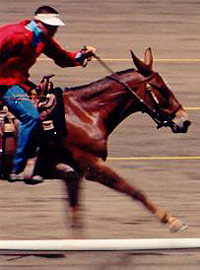 |
 |
 |
 News Around the Republic of Mexico | May 2005 News Around the Republic of Mexico | May 2005  
Race Donkeys Live Like Horses
 Morgan Lee - Associated Press Morgan Lee - Associated Press


| | With somewhere between two million and three million burros, Mexico ranks behind only donkey-dependant China and Ethiopia. |
Otumba, Mexico - A shaggy donkey named El Moro ordinarily spends his days towing a cart weighed down with tall canisters of pulque, the fermented juice of the spiny desert maguey plant.

But on a recent Sunday, the beast of burden raced past screaming crowds to victory in Mexico's annual burro derby, winning by a length to bring home a $550 US purse - about five times its sale value. "I hit him and squeezed him hard," said Juan Carlos Lopez, a 14-year-old jockey who rode without stirrups in a reclining wind-blown position to defeat the two-time reigning champion, a burro named Simpatico.

The race was part of Mexico's most popular donkey festival, held at Otumba, a village of about 10,000 residents in Mexico's central highlands that pays tribute each year to its animal labourers in ribald tongue-cheek style.

Burros dressed as the Mexican president, the first lady, a Chinese dragon and even the popemobile paraded with their owners around the village plaza, competing for best costume. This year's burro queen, Julia Munoz, 22, rode on the hood of a fur-coated convertible.

It was a rare day of acknowledgement for a downtrodden pack animal.

"They are used to haul water, to take kids to school, to carry home drunks - they're used for everything," said Aline S. de Aluja, a veterinarian in Mexico City. "Burros are docile animals, easy to lead and they suffer because really nobody pays attention to them."

A supervisor of two travelling clinics for donkeys, mules and workhorses at the National Autonomous University of Mexico, Aluja has mixed feelings about the Otumba fair and no longer attends.

"It's a thing where the people have fun, but the burro doesn't," she said.

Burros at the fair bore the scars of poorly improvised saddles and harnesses. Some had to be wrestled through a noisy tent packed with bleachers, a marching band, mariachis and judges who awarded prizes based on the volume of applause.

A donkey caller hee-hawed into the microphone; only one donkey brayed back.

But in the months leading up to the fair, racing burros eat the best fodder their handlers can buy, living for a short time like, well, horses.

Second-place Simpatico won his hay for the next year and then some, according to members of the farming cooperative where the burro works hauling loads of edible cactus.

For visitors clutching donkey dolls and trinkets, the fair has become a hallowed, if silly, celebration.

"I think it's something very traditional, very beautiful and very out of the ordinary," said Juan Senteno, a government worker who travelled from across the state to see the donkeys strut.

Otumba became known for its burros centuries ago when it still served as an overnight rest stop for Spanish caravans ferrying loot between the Gulf coast port of Veracruz and the capital, Mexico City.

An old refrain - "for burros, go to Otumba" - dogged the town until residents decided to embrace the legacy - kicking off the first festival 40 years ago, recalled Ernesto Gomez Aco, 70, the town historian.

The festival even caught on with Mexico's entertainment elite during the 1970s, when professional wrestler Enrique Llamas, an Otumba native, brought home friends and colleagues from the television networks.

With each year, city hall posts new burro regulations containing rules of the race that also lampoon current political events.

Despite all the fuss, the burro populations appear to be on the decline in Otumba, as residents upgrade to cars and trucks, organizers of the festival said.

The burro polo tournament, played with brooms on a small asphalt court, was cancelled this year when nobody showed up.

But donkeys are in no danger of disappearing from rural Mexico, according to Robert Nichols, overseas project manager for The Donkey Sanctuary, a British donkey welfare organization.

With somewhere between two million and three million burros by Nichols' estimate, Mexico ranks behind only donkey-dependant China and Ethiopia.

As donkey owners upgrade to horses or tractors, other farmers scrape together the money for their first burro, an animal that still pulls its weight economically.

"If you don't have a donkey, you're a donkey yourself," said Nichols, citing an Ethiopian saying.

Thousands of spectators lined the streets for the final heat of the burro race, literally rubbing elbows with the riders along the narrow course.

The sport has not caught on elsewhere in Mexico. Speed may be an issue.

Hilario Gutierrez boasted that his burro can sustain 10 kilometres per hour - but only for up to 100 metres.

"They're not fast," acknowledged Maria Cristina Cortes, an Otumba city regent. "The steps a burro makes are tiny. They're little bitty jumps, springs."

Oversized jockeys rode atop the burros' firm hind quarters, nearly touching the ground with their feet as they bumped along a 200-metre course. One rider said he weighed 155 pounds, while his burro weighed 440 pounds.

There are no plans to open the sport to betting.

"It's not allowed here," Gutierrez said. "Where there are bets, later there are problems. This is for fun. It's a fair." | 
 | |
 |



